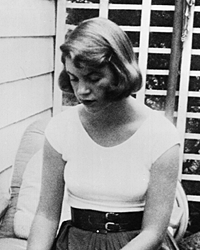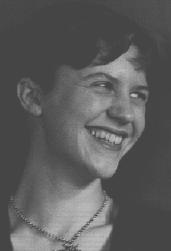

Throughout the late Sylvia Plath's short lifetime, she suffered many personal struggles. These struggles include the early death of her father who died as a result of diabetes when she was still very young. Later in her life, Plath's husband, Ted Hughes, left her for another woman. Plath suffered greatly from the loss of her husband. These events only made her life- long chronic depression worse, causing her to attempt suicide many times until she finally succeeded at age 30 by sticking her head in the oven and suffocating from gas poisoning. These three main struggles in Plath's life are reflected in her auto- biographical novel, The Bell Jar, and in her poems "Lady Lazarus" and "Daddy".
Sylvia Plath's life and the struggles she faced are mirrored in The Bell Jar. Many similarities are seen in both Plath's life and in Esther Greenwood's life. Esther Greenwood is the main character in The Bell Jar, playing out the events that happened to Plath herself. Esther faces many conflicts throughout the novel almost exactly the same as the conflicts Plath encountered during her lifetime. Plath's chronic depression and suicidal tendencies are similar to those of the character Esther Greenwood. "Esther sees suicide not so much as self-destruction, [but more] as a theatrical ritual which would free her from her ‘factitious' identity and restore her to singularity." (Bloom, 46) It is seen in the novel that Esther wants to destroy her image through various suicide attempts as a result of low self-esteem.
In the novel, Esther Greenwood doubts her own intellectual ability. This is the result of her failure to be accepted into an important writing course. This leads her to believe that she is not good enough to live. After attempting suicide, she finds herself institutionalized, receiving treatment for her depression under the supervision of doctor. This same situation occurred in Sylvia Plath's life. The Bell Jar acts as a diary because it displays how Sylvia Plath reflects her own perception of the important events that occurred in her life into her writing.
Several events in Plath's life that deal with her personal struggles coincide with those events in the novel. Both Esther Greenwood and Sylvia Plath's suicidal tendencies are a result of anxiety. Plath's attempt at suicide by overdosing on sleeping pills is mirrored in the novel when Esther makes the same attempt. Plath and her autobiographical character, Esther, are both institutionalized and treated for their depression with electric shock.
 In both Sylvia Plath's life and the character Esther Greenwood's, there is a sense of abandonment due to the death of her father, Otto Plath, when she was still quite young. Her struggles to deal with the absence of her father is reflected in the poem "Daddy". When Plath's father died because of a severe case of diabetes, Plath both loved him and hated him. He was a wonderful father, up until he was bed-ridden with his illness, but when he passed away, Plath, being at the young, tender age of eight years old, hated him for leaving her. In "Daddy", images of horror are seen as a reflection of the abandonment she felt of the father-figure in her life. She uses images of Satan, Dracula, and even concentration camp commanders to reflect her bitterness of being abandoned by both her father and, later in her life, her husband. In this poem, "Daddy's victim has become as terrible as her tormenter, who courts death and destroys husbands as the surrogates of her father." (Bassnett, 30) The images of the concentration camp commanders can be linked back to her father's German background. Other Nazi images, such as the use of words from the German language like "ich" (meaning "I") and "du" (meaning "you"), are recurring in both of the poems "Daddy" and "Lady Lazarus".
In both Sylvia Plath's life and the character Esther Greenwood's, there is a sense of abandonment due to the death of her father, Otto Plath, when she was still quite young. Her struggles to deal with the absence of her father is reflected in the poem "Daddy". When Plath's father died because of a severe case of diabetes, Plath both loved him and hated him. He was a wonderful father, up until he was bed-ridden with his illness, but when he passed away, Plath, being at the young, tender age of eight years old, hated him for leaving her. In "Daddy", images of horror are seen as a reflection of the abandonment she felt of the father-figure in her life. She uses images of Satan, Dracula, and even concentration camp commanders to reflect her bitterness of being abandoned by both her father and, later in her life, her husband. In this poem, "Daddy's victim has become as terrible as her tormenter, who courts death and destroys husbands as the surrogates of her father." (Bassnett, 30) The images of the concentration camp commanders can be linked back to her father's German background. Other Nazi images, such as the use of words from the German language like "ich" (meaning "I") and "du" (meaning "you"), are recurring in both of the poems "Daddy" and "Lady Lazarus".
Plath's struggle with male-figures, mainly the death of her father and the abandonment and betrayal of her husband, Ted Hughes, is seen in her poem "Lady Lazarus". There is a direct connection between masculinity and evilness. Plath's feeling that she has been wronged by men is seen in the imagery of "Lady Lazarus". Images of men melting and burning her down to nothing except "..a cake of soap, a wedding ring, a gold filling"1 is a reflection of how she feels that men have oppressed her. The mention of the wedding ring shows that she feels her husband betrayed and oppressed her as well. The word "Herr", which is the German equivalent of the title "Mister" or "Mr.", is used to identify all men as one common entity. This emphasizes her perception that all men are evil and all men are out to betray her. The last lines of the poem1 are "a warning to all men and to system of male values" (Bassnett, 115) that have wronged her. Her chronic depression is only made worse by being hurt by the two major male figures in her life; her father and her husband. The poem "Lady Lazarus" is about a male figure who "fails in the attempt to incinerate the protean female force and who must witness her fiery ascension." (Bloom, 87) All of the male figures who have oppressed her and drove her to kill herself will get what they deserve after she is gone and somehow resurrected. Her angst against men is quite possibly the basis of her desires to leave this world by means of suicide.
Examining the struggles Sylvia Plath encountered during her life, her writings clearly explain in detail her feelings and perceptions of each mentally and emotionally scarring event she faced. Images of her pain and suffering are reflected in her writings through the use of imagery surrounding her visions of abandonment, repetition of German words, and re-living her depression through another person, namely the fictional character, Esther Greenwood. These struggles, from chronic depression, to her father's death, to the betrayal of her husband are all reflected in her autobiographical novel, The Bell Jar, and in her poems "Lady Lazarus" and "Daddy".
 Links to other sites on the Web
Links to other sites on the Web
© 1997 bethany@mail.ameritel.net